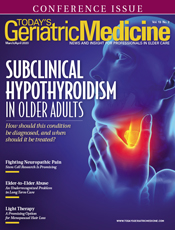
March/April 2020
The Last Word: Navigating the Complexities of Nontuberculous Mycobacterial Lung Disease With age comes a greater susceptibility to infections and diseases, including chronic respiratory conditions such as bronchiectasis or other structural lung conditions.1,2 However, symptoms of these more commonly diagnosed lung diseases—including chronic cough, dyspnea, fatigue, night sweats, and weight loss—may overlap with and mask a lesser known bacterial infection called nontuberculous mycobacterial (NTM) lung disease.3,4 This makes NTM difficult to identify, often delaying diagnosis and leading to a decline in lung function, worsening symptoms, and a decrease in overall quality of life.5 If a patient with preexisting respiratory issues such as asthma or COPD is currently under care but experiencing additional symptoms that are not responding to treatment, it may be time to consider the possibility of bronchiectasis and NTM lung disease.6 In addition to having a preexisting lung condition, other NTM lung disease susceptibility factors include being immunocompromised or immunosuppressed, female, and older than 65.1,3 A combination of these factors should prompt an initial sputum test, including an acid-fast bacillus culture or other routine respiratory culture to determine the specific bacterial pathogen that may be a source of the patient’s symptoms.6 In addition, the American Thoracic Society (ATS)/Infectious Diseases Society of America (IDSA) identify clinical and radiographic criteria for a diagnosis of NTM.6 If a patient has a positive sputum culture for NTM or shows radiographic pulmonary abnormalities with clinical symptoms of NTM, it’s important to consider engaging a pulmonologist or infectious disease specialist early in the patient’s evaluation process for further testing, treatment identification, and disease management.6,7 It Takes a Village In addition to a pulmonologist and infectious disease specialist, it’s often recommended that patients consult a respiratory therapist, nutritionist, rheumatologist (if they have an underlying rheumatologic diagnosis), audiologist, and ophthalmologist, to ensure related comorbidities and other health issues are being addressed simultaneously. Emotional and behavioral health resources should also be considered to help these generally older patients cope with the chronic nature of the disease. Through the collaboration of a multidisciplinary team approach to NTM patient care, physicians can better address underlying pulmonary and autoimmune conditions and help facilitate more successful disease management overall. The Complex Treatment Journey The ATS/IDSA recommends a multidrug antibiotic regimen as first-line therapy for NTM patients; the frequency of dosing and specific antibiotics included in the regimen can vary based on NTM species, disease severity, and initial presentation.6,8 It’s crucial to be upfront with patients about potential treatment side effects and frequently follow up with patients on a multidrug regimen to monitor their progress and ensure the therapy is working.6 In addition to managing NTM lung disease with prescription medications, which can feel overwhelming, there are several lifestyle modifications that NTM patients can employ to improve their quality of life. For instance, diligence with airway clearance practices are integral to improving symptoms. Other considerations include avoiding potential environmental factors, such as hot tubs or indoor pools, and wearing masks when gardening or participating in other outdoor activities that may increase exposure to the bacteria.6 The Patient’s Support System An NTM diagnosis is complicated, as it usually does not develop in isolation and without other comorbidities, yet this infection can be manageable with the right care team and treatment plan. Successful disease management involves the partnership of the patient, their loved ones, and the full care team to ensure all symptoms and associated conditions are addressed in a timely and appropriate manner. — Wendi Drummond, DO, is an infectious disease specialist at Providence Portland Medical Center in Portland, Oregon and affiliate assistant professor at Oregon Health and Science University, Portland State University School of Public Health. She reports the following disclosure: receiving consulting or grant support from Insmed Incorporated.
References 2. Andréjak C, Nielsen R, Thomsen VØ, Duhaut P, Sørensen HT, Thomsen RW. Chronic respiratory disease, inhaled corticosteroids and risk of non-tuberculous mycobacteriosis. Thorax. 2013;68(3):256-262. 3. Donohue MJ, Mistry JH, Donohue JM, et al. Increased frequency of nontuberculous mycobacteria detection at potable water taps within the United States. Environ Sci Technol. 2015;49(10):6127-6133. 4. Strollo SE, Adjemian J, Adjemian MK, Prevots DR. The burden of pulmonary nontuberculous mycobacterial disease in the United States. Ann Am Thorac Soc. 2015;12(10):1458-1464. 5. Park HY, Jeong BH, Chon HR, Jeon K, Daley CL, Koh WJ. Lung function decline according to clinical course in nontuberculous mycobacterial lung disease. Chest. 2016;150(6):1222-1232. 6. Griffith DE, Aksamit T, Brown-Elliott BA, et al. An official ATS/IDSA statement: diagnosis, treatment, and prevention of nontuberculous mycobacterial diseases. Am J Respir Crit Care Med. 2007;175(4):367-416. 7. Ryu YJ, Koh WJ, Daley CL. Diagnosis and treatment of nontuberculous mycobacterial lung disease: clinicians’ perspectives. Tuberc Respir Dis (Seoul). 2016;79(2):74-84. 8. Riello FN, Brígido RT, Araújo S, Moreira TA, Goulart LR, Goulart IM. Diagnosis of mycobacterial infections based on acid-fast bacilli test and bacterial growth time and implications on treatment and disease outcome. BMC Infect Dis. 2016;16:142. |
